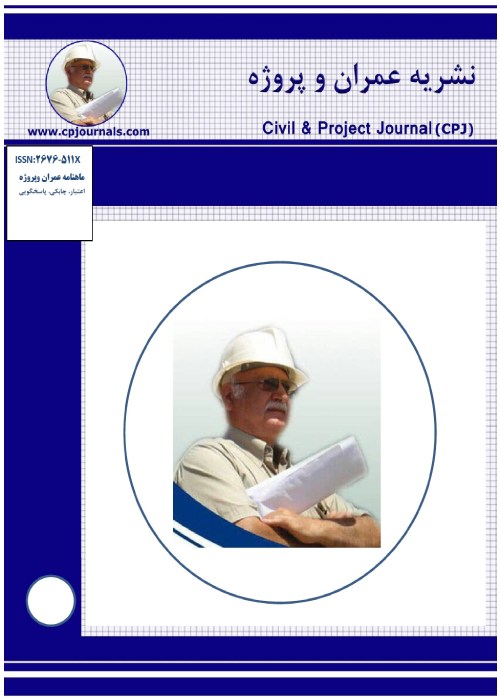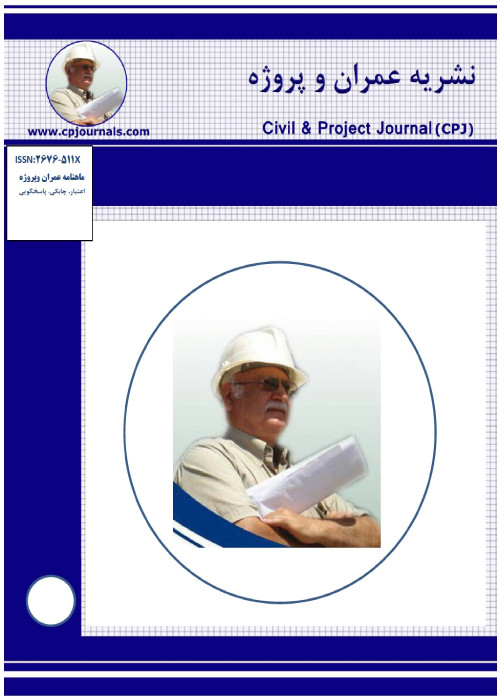فهرست مطالب

نشریه عمران و پروژه
سال پنجم شماره 3 (پیاپی 49، خرداد 1402)
- تاریخ انتشار: 1402/04/28
- تعداد عناوین: 4
-
صفحات 11-23تصادفات همواره یکی از چالش های حمل ونقل می باشد که سالانه به اندازه 3 درصد از تولید ناخالص ملی کشورها هزینه دارد. در این پژوهش، از یک مدل لوجیت چند جمله ای برای ارزیابی متغیرهای مرتبط با تصادفات خودروهای شخصی، تاکسی، اتوبوس، موتور و دوچرخه استفاده شده است. در این مدل، تصادفات خودروی شخصی به عنوان مرجع در نظر گرفته شده و با استفاده از مدل لوجیت چند جمله ای، مدلی بهتر و متناسب با داده ها ایجاد شده است. نتایج نشان می دهد که استفاده از دوچرخه و موتور نسبت به خودروی شخصی با احتمال بیشتری منجر به تصادف می شود، در حالی که استفاده از اتوبوس و تاکسی با احتمال کمتری همراه است. داده های استفاده شده در این تحقیق مربوط به سازمان حمل ونقل ترافیک شهر منچستر انگلستان می باشد که توسط پلیس راه در بازه زمانی سال های2010 تا 2021 جمع آوری شده است. نرم افزار آماری SPSS برای انجام مراحل ساخت مدل استفاده شده است و در هر یک از مدل های ساخته شده، تصادفات با توجه به نوع وسیله نقلیه مورد ارزیابی قرار گرفته اند. از مجموع 21 متغیر مورد استفاده، 13 متغیر در مدل به شکل معناداری تاثیرگذار می باشد. برای ارزیابی مدل ها، از شاخص Log likelihood استفاده شده که در مدل اول، این شاخص برابر با 662/58998 و در مدل دوم برابر با 09/80427 است. با توجه به این نکته که شاخص در مدل دوم بالاتر است، مدل دوم به عنوان مدل بهتر در این پژوهش انتخاب می شود. از نتایج بر می آید که متغیرهای انحراف از مسیر، سفرهای شخصی و جنسیت راننده بیشترین سهم را در تصادفات دارند.کلیدواژگان: مدل لوجیت دوجمله ای، احتمال تصادف، تصادفات دوچرخه، تصادفات جاده ای، نوع وسایل نقلیه
-
صفحات 24-37
سالانه حوادث جانی و مالی زیادی در ایران به دلیل رخ دادن تصادفات رانندگی به وقوع می پیوندد، به همین دلیل نیاز به برنامه های راهبردهای و پیشگیری موثر می باشد. این مقاله به بررسی شاخص های ایمنی ترافیک برون شهری در ایران و مقایسه آن با کشورهای آسیایی می پردازد. در این مقاله، مفاهیم کلیدی ایمنی ترافیک برون شهری شامل سرعت، استفاده از کمربند ایمنی، سیستم های ترمز و... بررسی می شوند. سپس، شاخص های ایمنی ترافیک برون شهری در ایران و کشورهای آسیایی مورد بررسی قرار می-گیرند. در نهایت، با استناد به داده ها و آمار، تفاوت های ایمنی ترافیک بین ایران و کشورهای آسیایی مورد بررسی قرار می گیرند. در این پژوهش شاخص های ایمنی ترافیک شامل نسبت تعداد کشته ها به طول راه، نسبت تعداد زخمی ها به طول راه و نسبت تعداد زخمی ها به تعداد کشته شده ها بررسی شده است. با بررسی این شاخص ها در ایران و کشورهای پیشرفته و ثروتمند آسیا، پیشنهاد می شود با افزایش ایمنی خودرو، افزایش طول راه ها، اعمال قوانین سخت گیرانه تر و... در بهبود شاخص ایمنی ترافیک گام برداشته شود.
کلیدواژگان: ایران، آسیا، ترافیک، تصادف -
صفحات 38-59
ایران از جمله کشورهایی است که استعداد وقوع زلزله در آن بسیار بالا بوده و همواره زلزله باعث بروز خسارات فراوان جانی و مالی و اتلاف سرمایه های ملی شده است. بنابراین تحقیقات بسیاری روی پدیده زلزله و افزایش مقاومت ساختمانها و همچنین آسیب پذیری ساختمانها در کشورانجام شده است. نگاهی به خسارت های ناشی از زلزله های گذشته نشان می دهد که درصد بالایی از ساختمانهای موجود، به دلایل مختلف از مقاومت کافی و قابل قبولی در برابر زلزله برخوردار نمی باشند و غالبا الزامات آیین نامه های جدید را ارضانمی کنند، از این رو ضرورت تقویت این ساختمانها به جهت مقابله با نیروهای جانبی با روش های مقاوم سازی قابل اعتماد، آسان و سریع احساس می شود . بر همین اساس در تحقیق حاضر با توجه به اهمیت موضوع، ضمن ارایه مراحل ارزیابی لرزه ای سازه ها سعی شده است تا روش های متفاوت و کارآمد مقاوم سازی سازه های بتن آرمه بر حسب نوع کاربرد تشریح گردیده تا افق استفاده از روش های کارآمد و قابل اعتماد روشنتر گردد.
کلیدواژگان: مقاوم سازی، میراگر، سیستم NSM، FRP -
صفحات 60-69
از آنجا که سرمایه گذاری در هر حوزه ای همراه با ریسک و عدم اطمینان است این مقاله به دنبال آن است که ریسک های سرمایه گذاری را در صنعت، شناسایی و اولویت بندی کند. ارزیابی میزان ریسک سرمایه گذاری در این پروژه ها یکی از مسایل کلیدی در حوزه سرمایه گذاری در صنایع دارای فناوری پیشرفته به شمار می رود. آنچه آشکار است این است که بین محیط ها و نظام های اداری فضای کسب وکارکشورهای مختلف، تفاوت زیادی وجود دارد؛ لذا معیارهای موثر در سرمایه گذاری در کشورهای مختلف یکسان نیست. امروزه مدیریت ریسک راهکاری مناسب برای مقابله با ریسک هایی می باشد که ممکن است در یک پروژه رخ دهد. در تحلیل واکنش ریسک، ریسک ها اغلب دارای وابستگی متقابل فرض می شوند، درواقع ریسک ها در یک پروژه متقابلا روی هم تاثیرمی گذارند و ریسک مستقل به ندرت وجود دارد. علاوه بر این، اجرای مدیریت پروژه های مختلف ازجمله پروژه های ساختمانی دارای موارد مبهم فراوانی است. هدف از مدیریت ریسک پروژه برنامه ریزی، سازماندهی، هدایت وکنترل فعالیت ها و فرآیندهای یک پروژه است. به گونه ای که اثرات مثبت (فرصت ها) بیشینه و اثرات منفی (تهدیدها) کمینه گردد. یک فرآیند سیستماتیک برنامه ریزی برای شناسایی آنالیز و پاسخگویی و زیر نظرگیری ریسک پروژه این مدیریت شامل فرآیندها، ابزارها وتکنیک هایی است که به مدیر پروژه برای بیشینه سازی احتمال نتایج رویدادهای مثبت و کمینه سازی احتمال نتایج رویدادهای منفی کمک می کند. با بکارگیری فرآیند کامل مدیریت ریسک پروژه می توان ادعا کرد که این مدیر پروژه است که به شرایط غیرقطعی پروژه اشراف دارد نه آنکه شرایط واتفاقات، مدیریت را اسیر خود می کنند. هدف از تهیه این مقاله بررسی ریسک های موجود در پروژه های سرمایه گذاری و ارایه راهکارها برای کنترل یا تخفیف آنها بوده است.
کلیدواژگان: مدیریت ریسک، پروژه های سرمایه گذاری، اولویت بندی ریسک
-
Pages 11-23Road accidents pose a persistent challenge to transportation systems, costing approximately 3% of the gross national product of countries annually. In this research, a multinomial logit model (MNL) was employed to assess variables associated with accidents involving private cars, taxis, buses, motorcycles, and bicycles. Private car accidents were considered as the reference category, and the multinomial logit model was used to create a more accurate and data-driven model. The results indicated that the use of bicycles and motorcycles had a higher likelihood of accidents compared to private cars, while buses and taxis had a lower likelihood. The data used in this study were collected by the Traffic Transport Organization of Manchester, England, from the years 2010 to 2021. The statistical software SPSS was utilized for model construction, and accidents were evaluated based on the type of vehicle. Out of the total of 21 variables used, 13 variables were found to have a significant impact in the model. The Log likelihood (LL) was employed to evaluate the models, resulting in a value of 58998.662 for the first model and 80427.09 for the second model. Considering the higher Log likelihood value in the second model, it was selected as the superior model in this research. The findings revealed that variables such as deviation from the route, personal trips, and driver gender contributed the most to accidents.Keywords: Multinomial Logit Model (MNL), Accident Probability, Bycicle Accidents, Road accidents, Type of Vehicle
-
Pages 24-37
Annually, Iran experiences numerous fatal and financial accidents due to traffic collisions, emphasizing the need for effective strategic plans and prevention measures.This article examines the indicators of suburban traffic safety in Iran and compares them with Asian countries. In this article, key concepts of suburban traffic safety, including speed, seat belt usage, braking systems, etc., are investigated. Then, the indicators of suburban traffic safety in Iran and Asian countries are examined. Finally, based on data and statistics, the differences in traffic safety between Iran and Asian countries are discussed. In this study, traffic safety indicators such as the ratio of fatalities to road length, the ratio of injuries to road length, and the ratio of injuries to fatalities are examined. By examining these indicators in Iran and advanced and wealthy Asian countries, it is suggested that by improving vehicle safety, increasing road length, enforcing stricter laws, etc., steps can be taken to improve traffic safety indicators.
Keywords: Iran, Asia, Traffic, Accidents -
Pages 38-59
Iran is one of the countries where the probability of earthquakes is very high, and earthquakes have always caused numerous human and financial losses and the loss of national capitals. Therefore, many researches on the phenomenon of earthquakes and increasing the resistance of buildings as well as the vulnerability of buildings have been done in countries. A look at the damages caused by past earthquakes shows that a high percentage of the existing buildings do not have sufficient and acceptable resistance against earthquakes for various reasons and often meet the requirements of the new codes.They do not, therefore, the need to strengthen these buildings in order to face the side forces with reliable, easy and fast resistance methods is felt. On this basis, in the current research, considering the importance of the subject, while presenting the seismic evaluation stages of the structures, an effort has been made to explain the different and effective methods of strengthening the reinforced concrete structures according to the type of application. More efficient and reliable methods will be
Keywords: Reinforcement, damping, NSM, FRP system -
Pages 60-69
Since investment in any field is associated with risk and uncertainty, this article seeks to identify and prioritize investment risks in the industry. Assessing the amount of investment risk in these projects is one of the key issues in the field of investment in industries with advanced technology. What is obvious is that there is a big difference between the business environments and administrative systems of different countries; Therefore, the effective criteria for investment in different countries are not the same. Today, risk management is a suitable solution to deal with risks that may occur in a project. In risk response analysis, risks are often assumed to be interdependent, in fact, risks in a project mutually influence each other, and independent risk rarely exists. In addition, the implementation of the management of various projects, including construction projects, has many ambiguous cases. The purpose of project risk management is to plan, organize, direct and control the activities and processes of a project. in such a way that the positive effects (opportunities) are maximized and the negative effects (threats) are minimized. A systematic process of planning to identify, analyze, respond and monitor project risk. This management includes processes, tools and techniques that help the project manager to maximize the probability of positive event results and minimize the probability of negative event results. By using the complete process of project risk management, it can be claimed that it is the project manager who is the master of the uncertain conditions of the project, not that the conditions and events make the management captive. The purpose of preparing this article was to examine the risks in investment projects and provide solutions to control or reduce them.
Keywords: Risk Management, Investment Projects, risk prioritization


